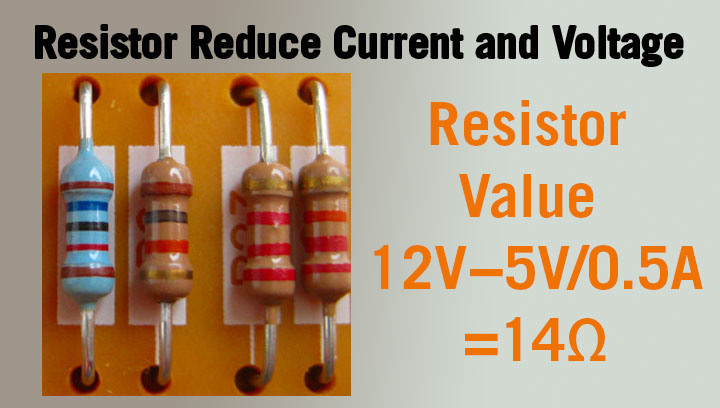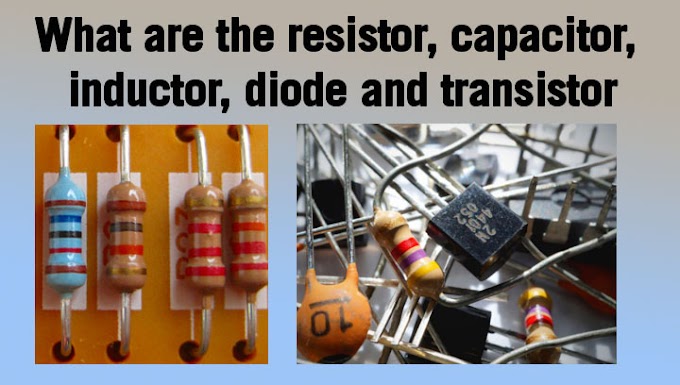The resistor reduces the current, just like the narrow pipe reduces the flow rate. The current before and after the resistor is the same, just like the flow rate before and after the narrow pipe is the same.
When you mention 12V 1A I will assume that you mean a 12V voltage source that can supply 1A This means that while the voltage is (more or less) fixed, the current is not. The current does not have to be 1A It could be less, but it can be a maximum 1A The current will depend on the resistance in the circuit.
You have a device or a chip that requires 5V with a max. current of 0.5A This means that we need to drop the voltage from 12V to 5V
If you’re using a series resistor, the remainder of the voltage will be dropped across your device. The value of the resistor would be: 12V−5V/0.5A=14Ω
There are several problems with this approach, however. The first problem is that we’re wasting a lot of power. Concretely, we’re dissipating 6Vx0.5A=3W to get 5Vx0.5A=2.5W of power. That’s only 2.5W/2.5W+3W ≈ 45% efficient.
The second problem is that your average resistor can only dissipate about 14W of power assuming the ambient temperature is low enough. We’re trying to dissipate more than 10 times as much power. That’s going to require a fairly beefy resistor. Not to the extent that it will be very hard to find, but it’s going to be more expensive than a standard resistor, which in turn will make the other options even more attractive.
The third problem is that the voltage will not be very stable. Your load will likely not be as stable as the 10Ω resistor I used to model this example. This can result in voltage spikes and drops and thus make the power supply unreliable, and it could even destroy your device.
The fourth problem is that your voltage source is unlikely to be a stable voltage source in the first place. If you’re starting from a 12V voltage source, my guess would be that it’s a 12V lead-acid battery (although most 12V batteries can deliver much more than 1A of current). The voltage of this battery will vary from 12.6V when fully charged to about 6V when fully discharged (although you shouldn’t discharge it this much). The voltage source’s voltage may vary, and thus the voltage drop across the load will vary as well:
When the battery voltage drops, we want the value of our series resistor to be lower as well, so that the voltage drop across the load can remain more or less constant. Fortunately, such a device does exist: it’s called a voltage regulator:
This will make sure that the output voltage is a more or less stable 5V ( 4.8V - 5.2V at room temperature). The most well-known (linear) voltage regulator is probably the 7805
This device would solve three out of four problems. It can handle power dissipation, depending on the ambient temperature, but you will likely need a heatsink. The voltage will be stable regardless of the input voltage (as long as it’s within range of what the 7805 can handle, which is Input 6V−25V ) and the load.
Which Electronic Component is Used to Limit the Flow of Current to The Device
Different electronic components are used for different things. When you need to limit the current flow to a device a resistor would be the component used. However the type of resistor and what extent of a limit needed will influence what is used.
Given resistors oppose and can regulate the flow of an electrical charge going through a component, usually an electrical circuit. But if you want to stop the flow of electricity in just one direction a diode can and often is used. A “semiconductor component that allows most of the electric current or flows of electrons in one direction (forward direction) while blocks most of the electric current in opposite direction (reverse direction). It consists of two terminals or electrodes: cathode and anode. The p-type material of a diode acts as anode and the n-type material acts as cathode,” we are informed.
Resistors are actually used to limit excessive current flow. Voltage and electrons come into play. "Think of voltage as a pressure or force that drives electrons" and "the number or quantity of electrons passing through a given point at any instant" is how current is measured. “Resistors do exactly what their name says; they resist. You can use them to limit current or voltage, depending on whether they are connected in series (one after the other) or in parallel (share the same connection points next to each other), StackExchange explains.
Looking at Ohm’s Law -(V=IR) - where V is voltage and I is current and R is resistance - the resistance is generated by the resistor and the equation tells us what degree of the resistor is needed. The law denotes a fundamental relationship of electronic circuits - if the resistance is fixed when you increase the voltage the current goes up - but impacted by the power of the resistor.
Can I use a resistor to decrease the voltages on a transformer?
Yes, you can use a resistor to reduce the voltage across the transformer, but it may not be the most efficient or effective way to do so. Transformers are usually designed to work with a certain input voltage and deliver a certain output voltage, so if you need to change the output voltage, you usually adjust the input voltage or use a transformer with a different turns ratio.
Using a resistor to drop the voltage on the output side of the transformer will work, but the voltage drop across the resistor will result in power loss. This is particularly problematic if the load on the output side of the transformer is variable, as the voltage drop across the resistor will change with the load, resulting in a variable output voltage.
If you need to adjust the output voltage of the transformer, it is usually best to use a voltage regulator or a transformer with a different turns ratio. This will provide a more stable and efficient solution than using a resistor.










